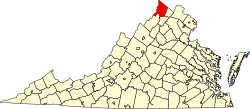Bartonsville, Virginia | |
|---|---|
| Coordinates: 39°6′41″N78°12′43″W / 39.11139°N 78.21194°W | |
| Country | United States |
| State | Virginia |
| County | Frederick |
| Time zone | UTC−5 (Eastern (EST)) |
| • Summer (DST) | UTC−4 (EDT) |
| GNIS feature ID | 1499094 [1] |
Bartonsville is an unincorporated community located along Opequon Creek in Frederick County, Virginia between Winchester and Stephens City. Bartonsville is on Springdale Road (SR 649) to the west of Valley Pike (US 11). Historically, it has been referred to as Barton's Mill and Bartonville. The area of Bartonsville was first settled by the Hite Family in 1733. It acquired its name from the Barton family, who owned various properties from c. 1801 to 1873.


